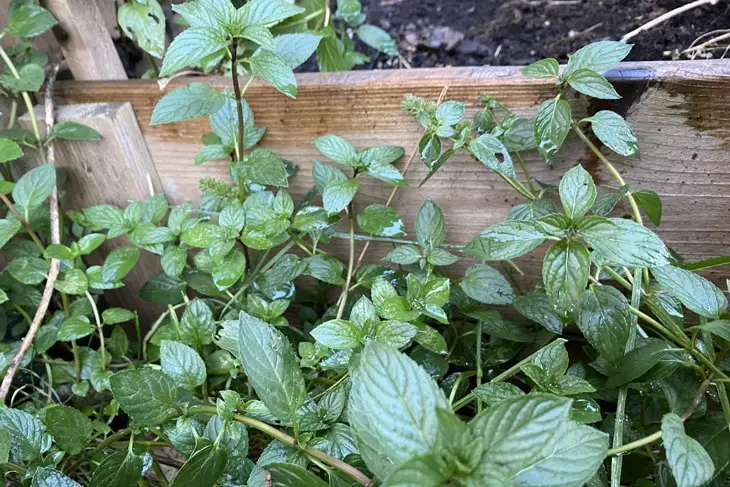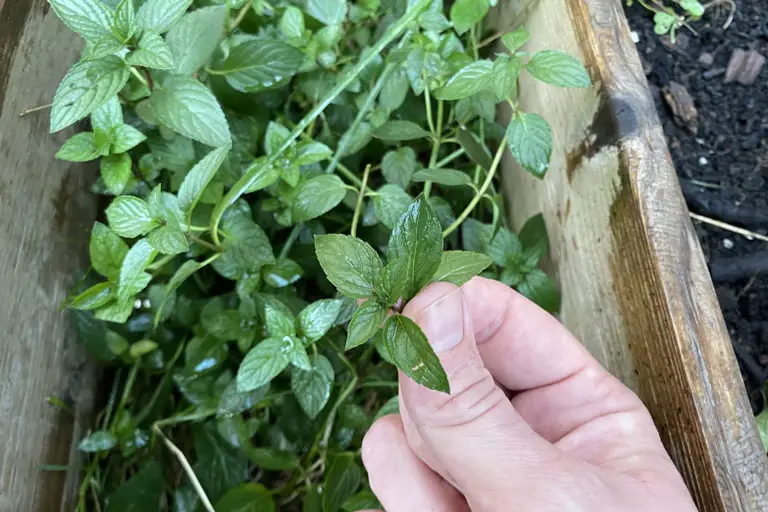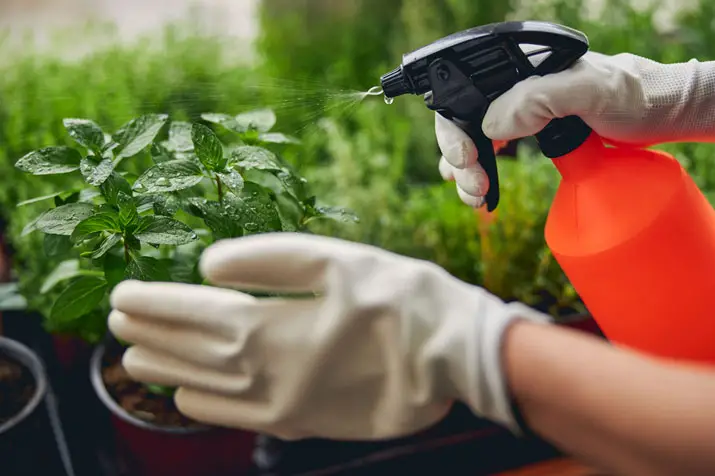How to Water Mint Plants – Avoid Over or Under Watering

This post follows our research editorial guidelines.

All summer you saw so many people on your social media feed talk about growing their own mint plants. In an effort to be more sustainable and grow your own mint to use in your water, salads, or smoothies, you went out to the store and grabbed everything you needed: pots, gardening tools, and a watering can. But now what?
If this is your first time growing your own mint, you may be wondering how often you should water mint so it doesn’t die.
Generally speaking, you should only need to water your mint plants twice a week, making it an excellent plant for beginners. According to Daniel Drost, a vegetable specialist, you should supply your mint plant with “…up to 1 to 2 inches [of water] per week, depending on temperatures, exposure, and soil conditions.”
I started growing mint during the pandemic and can speak from experience about how easy it is to maintain. That being said, there are a few tips you should keep in mind when watering your mint plant.

Table of Contents
Watering Mint Outdoors
Though a lot of people tend to grow mint inside, it’s still very common for homeowners to plant mint in their backyard, as well. If this is you and you want to know how often you should water your outdoor mint plant, you’ve come to the right place.
Generally speaking, you should only need to water your outdoor mint plant twice a week. If the soil surrounding your plant is unusually dry, it’s okay to give it a little extra hydration. But giving your mint plant too much water may result in root rot – a condition that can prove fatal to your plant.
When you set out to water your mint plants, aim to water them earlier in the day. Hydrated mint plants grow most successfully when exposed to sunlight, so the earlier you water them, the more benefits they’ll see later on throughout the day.
When Growing Mint From Seed
So you planted some mint seeds outdoors. Now what? One question you may be asking, besides how long they’ll take to sprout some mint seeds, is how often you should water them.
Let’s tackle that first question first. On average, it should take about two weeks for your mint seeds to sprout. However, keep in mind that you may see sprouts in as little as 10 days! While they’re germinating, you’ll want to water new seeds once a day in the mornings. As time goes on and your mint seeds start to mature, move the watering to every two days.
When Mint is Being Transplanted
If you’re like me, then chances are, you are constantly in the process of transporting your plants to a bigger pot or transplanting them into your garden to flourish. If you’re unfamiliar with the process, transplanting is the process of moving a germinated plant and replanting it in a new location.
You’re going to want to water your mint plant as soon as you transplant it to its new home. However, there are a few steps you’re going to want to take first:
- About three days before moving your mint plant, you’ll want to water it so it’s hydrated.
- Then, you’re going to want to prepare the new location where you intend to transplant your mint plant to. If you’re moving it from a pot to your garden, gently break up the soil until you reach a depth of about 10 inches. During this process, be sure to get rid of any weeds and rocks so it doesn’t interfere with your mint plant. This process also applies if you’re transplanting it from one spot in your garden to another.
- When you’re ready to make the transfer, dig up the plant and make a new hole that’s wide enough to contain the plant and its roots.
These tips make transplanting your mint plant easier than ever!

When Mint is Established
As we said earlier, you’ll start to see some progress on your mint plant in as little as 10 days. However, it’ll take about 90 days for the mint plant to fully mature. In other words, this is the timeframe in which the mint has grown to its full height. A little trivia for you: mint plants grow up to be up to 2-3 feet tall!
Fully established – or mature mint plants – should only need to be watered about twice a week. However, this may vary depending on the texture of the soil. Unlike other plants, mint absolutely hates growing in dry soil, so the minute you realize that the soil growing around it is dry, you should grab your watering can and hydrate, hydrate, hydrate. On average, this usually won’t extend more than three times a week, however, it’s going to depend on the climate and region you live in.
For example, mint does not grow well in areas that are either too dry or in soil that drain too quickly. Since mint prefers moist soil, planting in areas that have very dry climates such as Utah or Wyoming may not garner the best results, but it’s not impossible. Furthermore, mint tends to grow better in extremely sunny areas, though it can easily adapt to all climates, both warm and cold. The trick is to plant your mint at certain times of the season. For example, if you reside in a warm climate like Florida, plant your mint during the autumn season when temperatures are a bit cooler. In areas like New York that experience cold winters, plant your mint in the spring.
Watering Mint Indoors
But enough about mint and the great outdoors. If you’re like me and choose to grow your mint indoors, how often should you water it?
Watering Mint in Pots
Watering potted mint plants indoors isn’t too different from watering them outdoors. Generally speaking, you should only water your potted mint plants 2-3 a week, increasing the amount of hydration they get only if the top layer of soil gets too dry.
However, there are a few things to keep in mind when watering mint that’s potted indoors. Unlike the outdoors which may benefit from a cool breeze and shade, mint growing inside your house may be subjected to hotter temperatures, especially if you have them on display in muggy rooms of the house such as your kitchen or laundry room. These higher temperatures can cause your mint to wilt, but don’t be alarmed if you see this. Just add a little water to the pot and watch it bounce back to life (in some cases in as little as 15 minutes). The hotter your house is, the more often you may have to water your mint plant.
Growing Mint in Water
Unfortunately, even with proper care, your mint plant isn’t going to live forever. So, when it starts to show signs of dying such as the leaves turning yellow or flowers starting to form, it may be time to propagate the plant.
Propagation is the process of taking cuttings (aka stems) from the mother plant and placing them in water to create a brand-new one. Keep in mind that you can’t just cut anywhere. You want to cut your mint stem below the lowest node (the raised, bumpy area on your stem). This will allow new roots to sprout. I tried this recently and was pleasantly surprised by how quickly a new plant sprouted!
Generally speaking, this process can take anywhere from 6-8 weeks. Once you have your cuttings, place them in a jar, along with water, making sure to change out the water every 5-7 days. I typically use a mason jar when propagating, and it works wonders if you’re looking for a suggestion!

Does Mint Need Full Sun?
Mint prefers full sun, but it can just as easily grow in partially shaded areas, as well. If you reside in a particularly humid area of the country, try planting your mint somewhere that gets at least some shade during the day, so it’s not constantly exposed to the harsh sunlight.
Will Mint Survive Through the Winter?
This is a very common question new mint plant owners ask, and the answer is yes: mint will survive through the winter season.
Mint is an incredibly hardy plant, which means that it can survive a wide variety of weather conditions. This, along with the fact that it grows rather quickly, are just a few of the big reasons why farmers like to grow mint.
However, you should keep in mind that, even though mint can survive the winter season, you should avoid harvesting it as often as you would in the summer because the cold weather does stunt its growth a little bit.
Can Mint be Overwatered?
Yes, it can. Like most other plants, mint can be overwatered and as a result, suffer from severe damage such as root rot (which we’ll get into later).
As I briefly mentioned earlier, you should only be watering your mint plant twice a week, only increasing its water intake if the top layer of soil is dry. Even with this, you should never exceed watering your mint plant more than three times a week, regardless of whether it’s planted inside or out.
If you’re worried about whether or not you have overwatered your mint plant, here are some common signs to watch out for:
- Yellowing or brown leaves
- Weakened/soft stems that cause your mint plant to wilt
- Stunted growth
- Leaves start falling off
- Mold appears on either the plant itself or the soil near it
Oftentimes, especially if they’re new to gardening, new mint plant owners may try to add more water to the plant if it looks like it’s wilted and keep adding water to get it to liven up. Unfortunately, if a plant doesn’t liven up after being watered, it’s a sign that it’s been overwatered. Adding more water will only kill it faster, so give it a few days to see if you can recognize a difference.
What Are the Signs of Mint Root Rot?
As we briefly mentioned in the paragraph above, overwatering can lead to a plant condition known as root rot.
Your plant’s roots are how it gets the nutrients and oxygen it needs to grow. When the plant is overwatered, the excess water can’t drain properly, causing the roots to basically become water-logged and drown from not being able to get enough oxygen. As a result, this, in turn, kills your mint plant.
Unfortunately, root rot can kill a plant in as little as 10 days.
Final Thoughts
Did you recently buy your first mint plant? These tips can help you avoid root rot and grow it successfully. In fact, if you transplant your mint plant to your garden, it can live for up to five years, giving you ample opportunities to harvest it and add it to your favorite foods and drinks. Now that you have a good handle on caring for this popular herb, learn how to properly harvest mint and how often it should be done.
